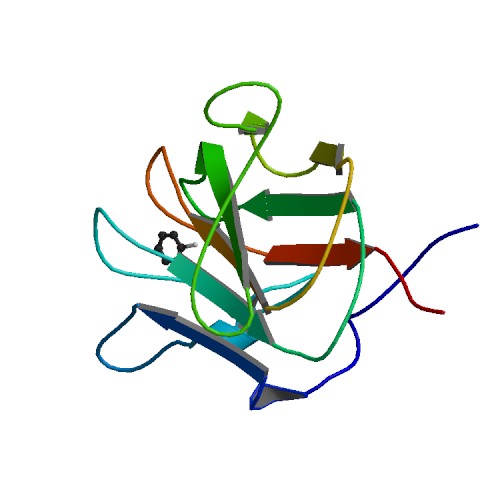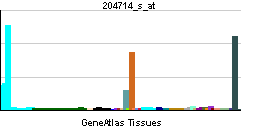Factor V
| Coagulation factor V (proaccelerin, labile factor) | |||||||||||
|---|---|---|---|---|---|---|---|---|---|---|---|
 PDB rendering based on 1czs. | |||||||||||
| Identifiers | |||||||||||
| Symbols | F5 ; FVL; PCCF; factor V | ||||||||||
| External IDs | Template:OMIM5 Template:MGI HomoloGene: 104 | ||||||||||
| |||||||||||
| RNA expression pattern | |||||||||||
 | |||||||||||
 | |||||||||||
| More reference expression data | |||||||||||
| Orthologs | |||||||||||
| Template:GNF Ortholog box | |||||||||||
| Species | Human | Mouse | |||||||||
| Entrez | n/a | n/a | |||||||||
| Ensembl | n/a | n/a | |||||||||
| UniProt | n/a | n/a | |||||||||
| RefSeq (mRNA) | n/a | n/a | |||||||||
| RefSeq (protein) | n/a | n/a | |||||||||
| Location (UCSC) | n/a | n/a | |||||||||
| PubMed search | n/a | n/a | |||||||||
|
WikiDoc Resources for Factor V |
|
Articles |
|---|
|
Most recent articles on Factor V |
|
Media |
|
Evidence Based Medicine |
|
Clinical Trials |
|
Ongoing Trials on Factor V at Clinical Trials.gov Clinical Trials on Factor V at Google
|
|
Guidelines / Policies / Govt |
|
US National Guidelines Clearinghouse on Factor V
|
|
Books |
|
News |
|
Commentary |
|
Definitions |
|
Patient Resources / Community |
|
Directions to Hospitals Treating Factor V Risk calculators and risk factors for Factor V
|
|
Healthcare Provider Resources |
|
Causes & Risk Factors for Factor V |
|
Continuing Medical Education (CME) |
|
International |
|
|
|
Business |
|
Experimental / Informatics |
Editor-In-Chief: C. Michael Gibson, M.S., M.D. [1]
Please Take Over This Page and Apply to be Editor-In-Chief for this topic: There can be one or more than one Editor-In-Chief. You may also apply to be an Associate Editor-In-Chief of one of the subtopics below. Please mail us [2] to indicate your interest in serving either as an Editor-In-Chief of the entire topic or as an Associate Editor-In-Chief for a subtopic. Please be sure to attach your CV and or biographical sketch.
Overview
Factor V is a protein of the coagulation system, rarely referred to as proaccelerin or labile factor. In contrast to most other coagulation factors, it is not enzymatically active but functions as a cofactor. Deficiency leads to predisposition for hemorrhage, while some mutations (most notably factor V Leiden) predispose for thrombosis.
Genetics
The gene for factor V is located on the first chromosome (1q23). It is genomically related to the family of multicopper oxidases, and is homologous to coagulation factor VIII. The gene spans 70 kb, consists of 25 exons, and the resulting protein has a relative molecular mass of approximately 330000.
Physiology
Factor V circulates in plasma as a single-chain molecule with a plasma half-life of about 12 hours. Half-lives up to 36 hours have been reported, though.
Factor V is able to bind to activated platelets and is activated by thrombin. On activation, factor V is spliced in two chains (heavy and light chain with molecular masses of 110000 and 73000, respectively) which are nonconvalently bound to each other by calcium. Factor V is active as a cofactor of the thrombinase complex. The activated factor X (FXa) enzyme requires Ca++ and activated factor V to convert prothrombin to thrombin on the cell surface membrane. This is considered part of the common pathway in the coagulation cascade.
Factor Va is degraded by activated protein C, one of the principal physiological inhibitors of coagulation. In the presence of thrombomodulin, thrombin acts to decrease clotting by activating Protein C; therefore, the concentration and action of protein C are important determinants in the negative feedback loop through which thrombin limits its own activation.
Role in disease
Various hereditary disorders of factor V are known. Deficiency is associated with a rare mild form of hemophilia (termed parahemophilia or Owren parahemophilia), the incidence of which is about 1:1,000,000. It inherits in an autosomal recessive fashion.
Other mutations of factor V are associated with venous thrombosis. They are the most common hereditary causes for thrombophilia (a tendency to form blood clots). The most common one of these, factor V Leiden, is due to the replacement of an arginine residue with glutamine at amino acid position 506 (R506Q). All prothrombotic factor V mutations (factor V Leiden, factor V Cambridge, factor V Hong Kong) make it resistant to cleavage by activated protein C ("APC resistance"). It therefore remains active and increases the rate of thrombin generation.
History
Until the discovery of factor V, coagulation was regarded as a product of four factors: calcium (IV) and thrombokinase (III) together acting on prothrombin (II) to produce fibrinogen (I); this model had been outlined by Paul Morawitz in 1905.[1]
The suggestion that an additional factor might exist was made by Dr Paul Owren (1905-1990), a Norwegian physician, during his investigations into the bleeding tendency of a lady called Mary (1914-2002). She had suffered from nosebleeds and menorrhagia (excessive menstrual blood loss) for most her life, and was found to have a prolonged prothrombin time, suggesting either vitamin K deficiency or chronic liver disease leading to prothrombin deficiency. However, neither were the case, and Owren demonstrated this by correcting the abnormality with plasma from which prothrombin had been removed. Using Mary's serum as index, he found that the "missing" factor, which he labeled V (I-IV having been used in Morawitz' model), had particular characteristics. Most investigations were performed during the Second World War, and while Owren published his results in Norway in 1944, he could not publish them internationally until the war was over. They appeared finally in The Lancet in 1947.[2][1]
The possibility of an extra coagulation factor was initially resisted on methodological grounds by Drs Armand Quick and Walter Seegers, both world authorities in coagulation. Confirmatory studies from other groups led to their final approval several years later.[1]
Owner initially felt that factor V (labile factor or proaccelerin) activated another factor, which he named VI. VI was the factor that accelerated the conversion from prothrombin to thrombin. It was later discovered that factor V was "converted" (activated) by thrombin itself, and later still that factor VI was simply the activated form of factor V.[1]
The complete amino acid sequence of the protein was published in 1987.[3] In 1994 factor V Leiden, resistant to inactivation by protein C, was described; this abnormality is the most common genetic cause for thrombosis.[4]
References
- ↑ 1.0 1.1 1.2 1.3 Stormorken H (2003). "The discovery of factor V: a tricky clotting factor". J. Thromb. Haemost. 1 (2): 206–13. PMID 12871488.
- ↑ Owren, PA (1947). "Parahaemophilia. Haemorrhagic diathesis due to absence of a previously unknown clotting factor". Lancet. 1: 446–51.
- ↑ Jenny RJ, Pittman DD, Toole JJ; et al. (1987). "Complete cDNA and derived amino acid sequence of human factor V". Proc. Natl. Acad. Sci. U.S.A. 84 (14): 4846–50. PMID 3110773.
- ↑ Bertina RM, Koeleman BP, Koster T; et al. (1994). "Mutation in blood coagulation factor V associated with resistance to activated protein C". Nature. 369 (6475): 64–7. doi:10.1038/369064a0. PMID 8164741.
Further reading
- Hooper WC, De Staercke C (2006). "The relationship between FV Leiden and pulmonary embolism". Respir. Res. 3: 8. PMID 11806843.
- Schrijver I, Houissa-Kastally R, Jones CD; et al. (2002). "Novel factor V C2-domain mutation (R2074H) in two families with factor V deficiency and bleeding". Thromb. Haemost. 87 (2): 294–9. PMID 11858490.
- Mann KG, Kalafatis M (2003). "Factor V: a combination of Dr Jekyll and Mr Hyde". Blood. 101 (1): 20–30. doi:10.1182/blood-2002-01-0290. PMID 12393635.
- Duga S, Asselta R, Tenchini ML (2005). "Coagulation factor V.". Int. J. Biochem. Cell Biol. 36 (8): 1393–9. doi:10.1016/j.biocel.2003.08.002. PMID 15147718.
- Andreassi MG, Botto N, Maffei S (2006). "Factor V Leiden, prothrombin G20210A substitution and hormone therapy: indications for molecular screening". Clin. Chem. Lab. Med. 44 (5): 514–21. doi:10.1515/CCLM.2006.103. PMID 16681418.
- Du X (2007). "Signaling and regulation of the platelet glycoprotein Ib-IX-V complex". Curr. Opin. Hematol. 14 (3): 262–9. doi:10.1097/MOH.0b013e3280dce51a. PMID 17414217.